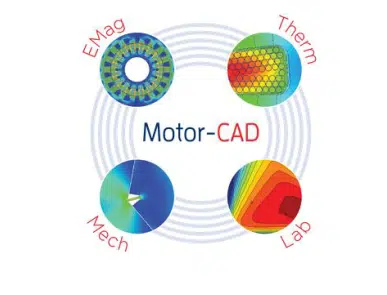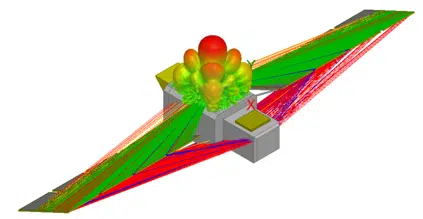Webinar Description | PCB Reliability Optimization using Ansys
Electronics are growing more complex and are also becoming limited in form factor.
More engineers are looking to predict the behavior and the reliable lifetime of their designs under real world conditions. SimuTech Group will be discussing simulations of printed circuit board (PCB) assemblies for all physics of interest for purposes of design, reliability, and regulatory testing.
Whether or not you are an electrical, mechanical, or reliability engineer, we will demonstrate the value-add in each field with Ansys tools such as Sherlock, Icepak, and SIwave, both of which feature highly automated workflows.

Materials for Printed Circuit Boards That Are Thermally Dependable in the Long-Term
The purpose of this webinar and the corresponding tests, is to establish the printed wiring board (PWB) material’s electrical strength-temperature Arrhenius curve (temperature life curve) for applications that go beyond the standard 5,000-hour end-of-life test specified in Underwriters Laboratory Standard UL746B2.
Data generated by the test technique described in this report correspond to 25K hours of operational life. The projected electrical strength of the different laminate materials under comparison can then be calculated using an extrapolation of the 25K hour test data to 100k hours.
By weighing the projected material degradation at 100K hours against the necessary dielectric needs over the course of the printed wiring board assembly’s service life, this data can be used to inform PWB design specifications. Then, design components can be changed. To guarantee that the PWB stays within the thermal boundaries set by the temperature life curve, this comprises material selection, stack up, trace size and spacing, copper weight, ground planes, and heat sinks.
Loss of Electrical Strength due to Thermal Exposure
For the estimated life of an application, thermal exposure-related loss of electrical strength must be a major factor in the design of a PWB.
When the insulation of the PWB operates at high temperatures, chemical reactions within the laminate are accelerated. The physical and electrical qualities of printed circuit boards deteriorate due to oxidation, which results in embrittlement, discoloration, and delamination.
When a laminate is aged at each of multiple increased temperatures, the changes in its properties to a preset level can be measured to determine the laminate’s thermal-aging characteristics. Dielectric strength is employed in this study to assess the relative impacts of various temperatures on the end of life for a particular insulating system.
Accurately Determining a PWB’s Thermal Aging Characteristics
The unclad laminate composite was the subject of much research into the thermal aging of laminate materials (resin and glass).
Temperature life testing needs to be done on a manufactured PWB rather than a raw laminate in order to accurately assess a PWB’s thermal aging properties. The operational life of a PWB will also be influenced by the internal design of the board (amount of heat sinking capacity, density of power generating components), as well as the intended use environment.
Additionally, manufacturing procedures may shorten a produced PWB’s service life. During fabrication, laminates will be subjected to a variety of chemical exposures, temperature excursions, and mechanical stressors. For pollutants to be eliminated, effective process control is essential.
This entails obtaining suitable bonding surfaces, ensuring strong adhesion, and guarding against thermal and mechanical damage to the laminate itself. Operational life may suffer if these processes spiral out of control or are ill-defined. When assessing data and estimating the operating life of a PWB, these intangibles must be taken into account.
Relative Indication for a PWB’s Service Life
The operational life of a laminate system in actual usage cannot be quantitatively correlated with the timeframes to failure in a thermal aging test.
They do, however, give a relative indicator of a PWB’s service life under the particular test conditions. Longer testing at lower temperatures can be conducted using the results of shorter tests at higher temperatures.
The amount of extrapolation that can be done using material life data is constrained by standards for material aging like UL 746B and IEEE STD 99.
They suggest that at least 25% of the material’s desired operational life should be tested during thermal aging tests. Test duration must be at least 25k hours in order to gather enough aging data to meet standards for 100k operational life.
Methodology for PCB Testing to Achieve 100K Hours of Operational Life | PCB Reliability
Following the test procedures and calculations given in IEEE98 A.1 and UL746B, a three stage process was used to determine the operational life of printed circuit board laminates after thermal aging, in tandem with overall PCB reliability.
This method of material testing helps match material properties with design requirements, enabling the implementation of suitable trace spacing or other countermeasures to achieve the target design operational life of 100,000 hours.
An outside reliability engineering firm advised on the test approach. To estimate the high temperature test boundary for long-term aging of PWB laminate material capabilities, Phase I entails a 500-hour pre-screen at four fixed temperatures in accordance with IEEE98 A.1 and UL746B 20A. The top performing material was sorted initially using pre-screen data.
PWB Laminate Material Characteristics for Long-Term Aging Testing (at High-Temp)
To determine the high-temperature test boundary for long-term aging testing of PWB laminate material capabilities, a 500-hour pre-screening test with four fixed temperatures was first used.
The Tg (Glass transition temperature) of the material was strongly considered in the selection of the highest temperature range. The four temperatures employed differed by material.
Using a production AC Dielectric Analyzer, the dielectric breakdown voltage was measured at time zero and 500 hours later at high temperatures. For each temperature, the percentage of dielectric strength retention compared to baseline tests was computed. These findings led to the assignment of the 50% EOL (end of life).
It was not employed to predict low temperature bounds due to the nature of short-term testing, since inadequate material change would be anticipated during testing. This is especially true when the temperature is low and lasts only briefly. This test is mostly based on the fixed time frame method (FTFM) of sampling described in IEEE STD 98.
Employing Thermal Endurance Graphs to Extrapolate and Validate Time-Sensitive Degradation Temperatures
To extrapolate and validate the 500 hour degradation temperature and the 5,000 hour degradation temperature for the 25,000 life test, a thermal endurance graph was developed using the short term aging for 1,000 hours at four updated, fixed temperatures.
This information was used to aid in the pre-screen analysis and the selection of aging temperatures. According to the pre-screen data and UL746A process, the temperatures employed in the 1000 hour test were more extreme.
To find any outliers or concerning behavior, data were initially evaluated in a manner akin to the pre-screen data. For an initial prediction of behavior and performance, Arrhenius plots were created.
Calculating Retention of Dielectric Strength at Each Temperature Interval | PCB Reliability
The percentage Retention of dielectric strength was estimated for 1,000 hours of short-term aging at each of four revised temperatures.
Next, percent Retention data was plotted against time (one curve per temperature) (x-axis). Based on this information, each material’s 50% end of life was calculated.
The temperatures for the long-term operational life test for 25K hours were chosen using an extrapolation and validation of the 500 hour deterioration temperature and 5k hour degradation temperature using a thermal endurance graph.
Interconnect Stress Testing (IST) and Highly Accelerated Thermal Shock (HATS) Testing
In addition to the thermal endurance test, the mechanical resilience of the plated through holes for each laminate was evaluated using the Interconnect Stress Test (IST) and the Highly Accelerated Thermal Shock (HATS) test.
A thermal endurance graph was created using long-term aging for 25k hours at four updated fixed temperatures in order to extrapolate and validate the operating life temperature for 100k hours.
Currently, the testing has been completed to around 40% of its potential.
A minimum of 25k hours will be spent on long-term aging. The 6-week test’s Arrhenius plots were used to forecast a specific degradation percentage over a specific period of time.


Results: Five PWB Laminates Tested for Thermal Aging by Material Inputs
From a considerably longer list of PWB laminates, the materials in the table below were narrowed down for inclusion.
To choose five laminates for thermal aging tests in this particular case study, criteria like press fit compatibility, comparative tracking index (CTI), flammability, dielectric breakdown voltage, and glass transition temperature (Tg) were used.
Table: Components Tested
| Component | Pervasiveness | Performance | Tg, Degrees⁰C | Electrical, RTI |
| Laminate A | Widely Used | Standard Performance
Epoxy |
180 | 130 |
| Laminate B | Limited Use – Application Specific | High Speed
Performance – Non- Epoxy Filled |
200 | 130 |
| Laminate C | Limited Use –
Application Specific |
High Temperature
Resistant – Filled |
190 | 130 |
| Laminate D | Limited Use – Application Specific | High Temperature Resistant – Filled | 160 | 160 |
| Laminate E | Specific Use (RF) | High Temperature /
Microwave – Filled |
>280 | 160 |





